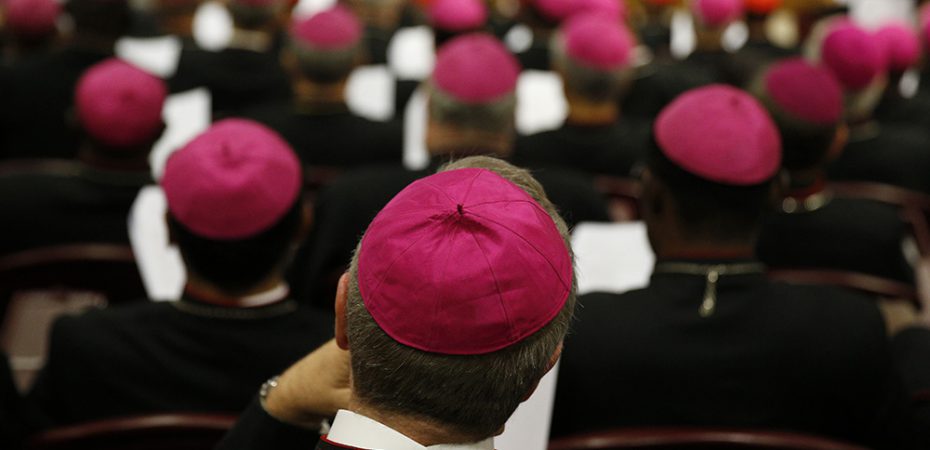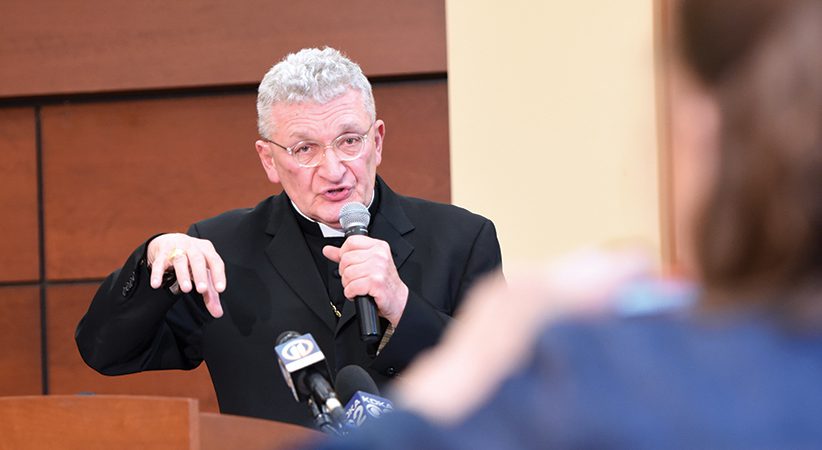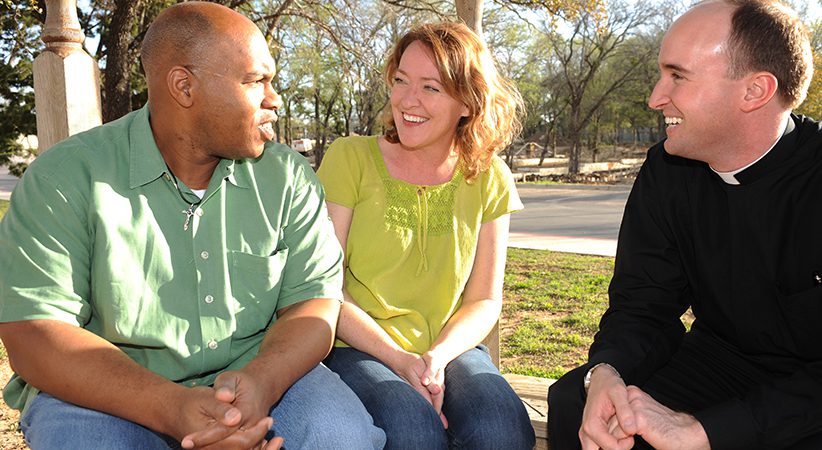Synodality: A Call to Journey Together in Faith
A plan for parishes, dioceses and bishops to prepare for the upcoming synod
Father Ronald D. Witherup Comments Off on Synodality: A Call to Journey Together in Faith
One of the unintended consequences of the COVID-19 pandemic was to force a delay for the Holy See’s plan to hold the next worldwide synod of bishops. Originally scheduled for the fall of 2022, Pope Francis made the decision to postpone it until October 2023 — and then added a surprise.
In place of the usual preparations for such a meeting of representative bishops from around the world, it was explained that a new synodal process itself would unfold and lead up to the synod. Before examining this situation, and what it might mean on a pastoral level, let’s clarify more precisely the concept of a synod and a little of its history.
Ecclesial Context
First of all, the word “synod,” which comes from two Greek words (syn, with, plus hodos, way or path) and means “walking together,” is almost exclusively a Church term. It denotes an assembly or gathering of churches or Church officials to discuss important topics or situations. It connotes a process of consultation and decision-making, which we can properly consider “collegial” in the sense that it invites a participation of multiple parties, often through elected or designated representatives.
In modern times, the synod of bishops’ structure was established by Pope St. Paul VI in 1965 only months before the closing of the Second Vatican Council. To mark the 50th anniversary in 2015, Pope Francis issued his own authoritative document on synodality, emphasizing that this process is constitutive of the Church’s existence at every level.
Synodality, as currently understood, consists of three phases. First is the preparatory phase, in which broad consultation is conducted to collect data from all levels of the Church on a theme chosen by the pope. The second is the celebratory phase, which takes place during the actual meeting of the synod’s representatives, mostly bishops. Francis has expanded synod membership recently, naming a French religious sister as undersecretary of the synod, with voting rights. Finally, there is the implementation phase, in which the synod’s conclusions are published, usually in the form of a papal apostolic exhortation. In practice, one of the questions experts have raised about past post-conciliar synods concerns the final product. Instead of it being a document summarizing the major conclusions that arose in the midst of the broad consultation and discussions, they were often seen as papal statements that did not always reflect the preferences of the synod’s participants, usually expressed in the form of propositions. In other words, synodal exhortations came to be seen as an extension of individual papal teaching authority rather than a summary of a widespread understanding of a specific topic.
Since Vatican II, there have been 15 ordinary synods of bishops, usually conducted every few years, and nearly an equal number of extraordinary synods to address critical topics. The synod of 2023 will be the 16th ordinary assembly. Every pope since the council, with the exception of John Paul I whose papacy lasted only 33 days, has convened synods, including Popes Paul VI, John Paul II, Benedict XVI and Francis.
Topics for ordinary synods have included justice in the world, consecrated life, priestly formation, the Eucharist, and the Word of God in the life of the Church. Extraordinary synods, on the other hand, have addressed issues pertinent to certain geographical regions (Africa, Asia, the Middle East, Lebanon, Oceania and, most recently, Amazonia) or narrow topics like the concerns of Ukrainian bishops or the bishops of the Netherlands.
Generally, the process for synods until recently has been fairly uniform. A group of experts and bishops under the direction of the general secretary of the synod of bishops — the pope is always the president — would prepare the preparatory document (lineamenta) to circulate around the world, to get feedback in order to prepare a working document (instrumentum laboris) to present to the assembled bishops at a synod, to help focus their discussions. Then at the conclusion of the synod itself — now reduced from four weeks to three — a set of propositions would be sent to the pope for his use in preparing a final document, usually an apostolic exhortation.
A Synod about Process
Usually, worldwide synods of bishops in the Catholic Church are held to analyze current critical issues facing the life of the Church. Vatican II (1962-65) obviously restored the ancient practice of synods that had largely disappeared over the centuries as power within the Church gradually narrowed to a strictly hierarchical exercise. When Pope Francis announced that the next synod of bishops would focus on synodality, in essence, he was making the focus on the process itself rather than on a separate theme.
Pope Francis has given particular emphasis to synods during his pontificate. In one of his addresses, he stated his view of the importance of synodality: “I am persuaded that in a synodal Church, greater light can be shed on the exercise of the Petrine primacy. The pope is not, by himself, above the Church; but within it as one of the baptized, and within the College of Bishops … called at the same time — as successor of Peter — to lead the Church of Rome.” There are some members of the Church, of course, and even the hierarchy, who are not particularly favorable to synodality. It can be messy, it takes more time, and it is often difficult to arrive at consensus.
For the synod of 2023, Pope Francis announced three phases: diocesan, continental and universal. The first commenced in October 2021 at which all dioceses around the world were invited to establish a yearlong consultative mechanism on the diocesan level to promote broad consultation among the faithful. A preparatory document, “For a Synodal Church: Communion, Participation, and Mission,” was promulgated in September 2021.
It emphasized the synodal path as a “journey together,” a participation in the Church’s identity as a pilgrim people. The three themes of communion, participation and mission embody the essential nature of synodality in the Church.
“Communion” emphasizes the goal of unity that mirrors the Trinity itself, which is unfortunately so lacking in today’s highly divided world. “Participation” is meant to invite everyone at every level to get involved in the synodal process. Thus it will proceed from the local to the universal level, involving the faithful, religious orders, lay associations and so on in order to get the widest possible consultation. Finally, “mission” recalls the essential nature of the Church as a community of faithful called to proclaim the Gospel of Jesus Christ at all times and in all circumstances. The Church exists to evangelize, in word and in deed, as missionary disciples; the synodal process is there to sustain this identity.
In addition to the principal document, the synod office issued a vademecum with concrete guidelines to help dioceses implement this broad consultation. It included the beautiful Adsumus prayer invoking the Holy Spirit, which was used at every session of Vatican II.
Interestingly, unlike previous synods, Pope Francis has shifted the purpose of synods to not merely focus on producing a document, but rather “to plant dreams, draw forth prophecies and visions, allow hope to flourish, inspire trust, bind up wounds, weave together relationships, awaken a dawn of hope, learn from one another and create a bright resourcefulness that will enlighten minds, warm hearts, give strength to our hands,” which he discussed in his opening address for the Synod of Bishops on Young People, the Faith and Vocational Discernment in 2018.
This is a much broader and less concrete goal, one meant to open all our hearts to conversion under the guidance of the Holy Spirit. The question can validly be raised: How does one ensure a truly synodal process of collegiality with a Church that numbers well over 1 billion people in diverse cultures? History, I believe, testifies to the value of synodality.
Biblical Background
Contrary to popular belief, the concept of synods is not a modern one. It is, in fact, a very ancient notion evident in the early Christian practice of holding ecumenical councils. The foundations of synodality can be traced in the early Church to the first great crisis recorded in the Acts of the Apostles: How should gentiles — that is, non-Jews — be incorporated into the Body of Christ? While the details of this controversy are complex, it essentially revolved around the question of whether gentiles needed to become Jews and to observe all the elements of the Torah in order to become followers of Christ.
Acts records how Paul and Barnabas saw their mission as outreach to gentiles to bring them in without requiring full adherence to the Jewish law, in particular to circumcision and the dietary rules. Acts 15:1-29 recounts the fact that the leaders of the Church, centered in Jerusalem, convened a council to address the question, which had become controversial. Debates went back and forth, with Paul and Barnabas describing how the Holy Spirit had been poured out upon the gentiles. Peter and James, leaders of the Church in Jerusalem, weighed in. After much discussion, an agreement was reached.
This early synod — council is too anachronistic and formal a word — even produced a document, a letter written by the apostolic leaders and sent to the gentiles being proselytized in Asia Minor. This meeting resulted in a compromise: only certain stipulations of the Torah would be asked of them, primarily some dietary rules and avoiding unlawful marriage. Paul’s version of this early synod recorded in Galatians 2 differs somewhat in details, but nevertheless affirms the actual meeting of Church leaders to resolve a burning question. In short, a precedent had been set; Church history shows that it became a model for moving the Faith forward by means of dialogue, consultation and collegial consensus building.
View from Ground Level
Some priests (let alone bishops!) are likely to ask themselves, why do I need to get involved in this synodal process? Don’t I have enough to do? Why add yet another layer of responsibility to an already overburdened agenda?
As a leader myself, I fully sympathize with such sentiments. We all have more than enough to do, and the complexity that has arisen because of the COVID-19 pandemic has made life difficult. Nonetheless, I believe we priests have a responsibility to do what we can to invite people and fellow presbyters to make sacrifices to participate. Each diocese and religious community will likely respond to the pope’s invitation in diverse ways. There is no need to create a huge, complicated process.
The goal, rather, is to seek ways to get people thinking about and reflecting on the ways the Church today can respond to the many neuralgic issues of the modern world. Homilies, bulletin inserts, perhaps even posters in vestibules can help prod the faithful to reflect on the synodal way. Utilizing already established means to encourage community among presbyters — convocations, retreats, days of recollection, support groups — could also be another method of promoting collegiality in ways that do not add to an already full agenda.
Another possible avenue is to consider exploring the Acts of the Apostles with parishioners through Bible-study groups and/or a series of homilies during the Easter season when readings come from this New Testament book. It is the one book that bears witness to the importance of journeying together in a synodal fashion; it actually calls Christianity “the Way” (hodos, Acts 9:2; 18:25; etc.) and promotes the Church’s pilgrim identity.
Dioceses, priests and parishes will be challenged to find creative ways to respond to this most recent synodal process, but I believe it has great potential to bear fruit if taken seriously. If the process can, in fact, help rekindle the spark of evangelization and the enthusiasm for our baptismal faith that all too often fades over time, then it will be worthwhile. The Holy Spirit is there to accompany us on our journey.
FATHER RONALD D. WITHERUP, PSS, is superior general of the Sulpicians and the author of many books on Scripture and theology, including “Gold Tested in Fire: A New Pentecost for the Catholic Priesthood” (Liturgical, 2012) and “Saint Paul and the New Evangelization” (Liturgical, 2013), a study of the 2012 synod on the new evangelization.





